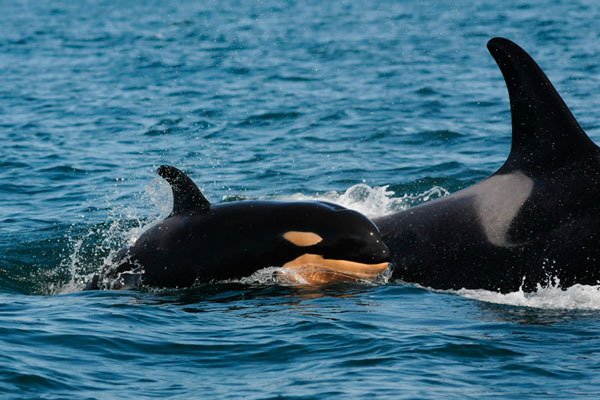If there happen to be more orca whales spotted along the coasts of Whidbey Island in the coming years, don’t attribute it to luck.
Five Southern Resident orca calves have been born in the Pacific Northwest since December, 2014, possibly due to a spike in the number of salmon reaching the ocean from the Columbia River, experts say. The most recent birth was announced by the Center for Whale Research on Sept. 17, when a Southern Resident orca calf was born in the Salish Sea.
The recent upswing in orca births is a sign of relief for the endangered Southern Resident orca population.
Howard Garrett, president of the South-Whidbey based Orca Network board, saw the births as a positive sign for the population.
“There’s an ongoing effort to understand what increases or decreases population,” Garrett said. “This really helps us see that correlation within a short time, a year or two. If there’s a burst in the number of salmon, then the population booms. This supports that hypothesis.”
As a result, the number of curious whale watchers has increased in Langley, according to Michaleen McGarry, executive director of the Langley Chamber of Commerce.
“There’s been a lot more talk of it and I think were gonna see more in the spring,” McGarry said. “They want more info and have been asking where they can take whale tours.”
Joel Ray, a marketing assistant at Clipper Navigation in Seattle, reported a correlation between the recent births and increase in tour sales.
“We have seen an uptick definitely in late summer watchings,” he said.
The orcas, which are often spotted in Admiralty Inlet and Saratoga Passage, can potentially be an economic boon for Langley.
“Anytime anybody comes here, they’re going to walk around Langley,” McGarry said. “Anytime you have an attraction, it’s going to affect the businesses.”
Yet dark days could still be ahead for the orcas. The Southern Resident population was listed as endangered in 2005, following a 20 percent drop in numbers from 1995-2000. During those five years, the whales suffered from heavy El Nino weather, according to Garrett.
Climate experts say there is a 95 percent chance that El Nino will strike the northern hemisphere during the winter of 2015.
“It’s a very scary prospect,” Garrett said.
Prior to the recent string of births, only one calf had survived during a two-year period from Aug. 2012 to Dec. 2014. During that time, Garrett predicts that salmon were impeded by the four Columbia River dams — Mica, Revelstoke, Keenleyside and Grand Coulee.
“They have to go through that metabolic transition from fresh water to salt water and they have to time that right, and that’s when the dams really do damage because they hold them back in the reservoirs because there’s no flow,” Garret said. “That delays their arrival at the sea, and yet their genetic timing for their transformation to salt water continues. So, they transform into saltwater fish long before they reach the saltwater and of course that cuts down survival right here, besides the fact there’s a lot of predators.”
Things may have been worse had it not been for court-ordered spillways across the four dams in 2006. Garret said the spillways increased the survival rate of smolt — salmon in the early stages of their life cycle — on their downward migration.
Garrett said he was increasingly pessimistic during the down years where no orcas were being born. That was until the first of five orcas were born. Their arrival was a relief, he said.
“I have become personally attached to these whales so I like to see them doing well,” Garret said. “They spread joy when people see them. Especially the babies. They’re bouncing around, looking energetic and they go off and have playtime together. That’s a joyful sight that I like to see and a whole lot of people like to see. I think they’re a bit of a mood-lifter for everybody. It’s a very good thing to see more babies.”



